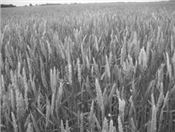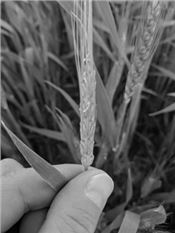|
Considerations For Fungicide Management Of Fusarium Head Blight (Scab) Of Wheat
DR. CARL A. BRADLEY
PRINCETON, KY.
Wheat fields are beginning to flower in western Kentucky. Flowering (anthesis) is a critical time, as wheat becomes susceptible to infection by Fusarium graminearum, the causal agent of Fusarium head blight (FHB; also known as scab) (Figure 1). This disease can cause reduced grain yield, test weight, and quality. In addition, the fungus can produce toxins that will contaminate grain such as deoxynivalenol (DON; also known as vomitoxin). Harvested grain with high levels of DON may be discounted or outright rejected at the elevator.
To achieve the best management of FHB, different management practices must be implemented, such as planting wheat into fields that were previously cropped to soybean (rather than corn), planting wheat varieties with moderate to high levels of resistance to FHB, and applying foliar fungicides at the proper timing. Of these different management practices, the application of foliar fungicides is the only one that can be done during the growing season and is the main focus of this article.
Foliar Fungicides
Multiple fungicides are registered for use on wheat, but only a few have efficacy in managing FHB. Fungicides available for FHB and DON management include Caramba (BASF Corporation), Miravis Ace (Syngenta Crop Protection), Prosaro (Bayer CropScience), Proline (Bayer CropScience), and multiple trade names of products that contain tebuconazole as their solo active ingredient. Of these products, the best efficacy has been obtained with Caramba, Miravis Ace, Prosaro, and Proline in multi-state university field research trials.
Fungicide products that contain strobilurin active ingredients should not be applied for control of FHB, and most do not list FHB control or suppression on their label. In multiple university research trials, strobilurin fungicides have been shown to increase DON levels in grain compared to non-treated checks. Therefore, it is extremely important that only effective fungicides be applied for management of FHB.
Application Timing
Proper fungicide application timing is critical in achieving the best efficacy. The best application timing is considered to be when plants are beginning to flower (early anthesis – Feekes growth stage 10.5.1; Figure 2), but some efficacy may still be achieved within a few days after Feekes 10.5.1.
Consider PreHarvest Interval (PHI)
In regards to fungicide application timing, it is important to always follow the label recommendations and consider the preharvest interval (PHI) requirements (PHI for Caramba, Prosaro, Proline, and tebuconazole products is 30 days, and Miravis Ace cannot be applied after the Feekes 10.5.4 growth stage).
Assess FHB Risk
When making a decision whether a fungicide application is needed, FHB risk should be assessed. A FHB Prediction Tool is available on-line. This risk is based on weather conducive for FHB, and should be assessed for each field as they begin to develop heads in anticipation of flowering. It is important to continually monitor the FHB Risk Prediction Tool as more and more wheat fields get closer to the flowering stage. ∆
DR. CARL A. BRADLEY: Extension Plant Pathologist, University of Kentucky

Figure 1. Symptoms of Fusarium head blight (scab) of wheat (note the “bleached” heads)
Photo: Carl Bradley, UK

Figure 2. A wheat head at the Feekes 10.5.1 growth stage (beginning anthesis).
Note the yellow anthers extruding from the middle part of the head
Photo: Carl Bradley, UK
|
|